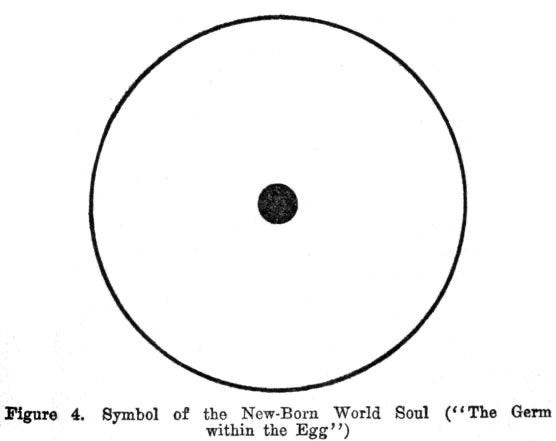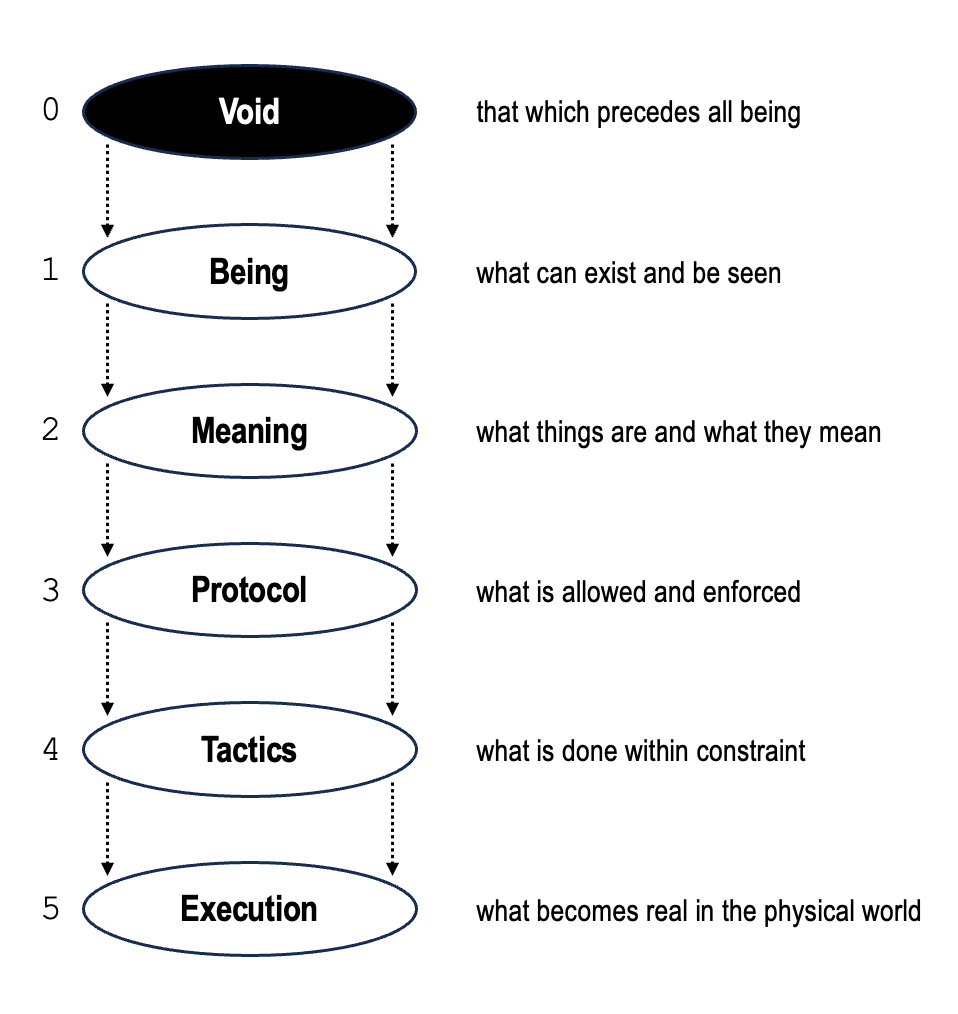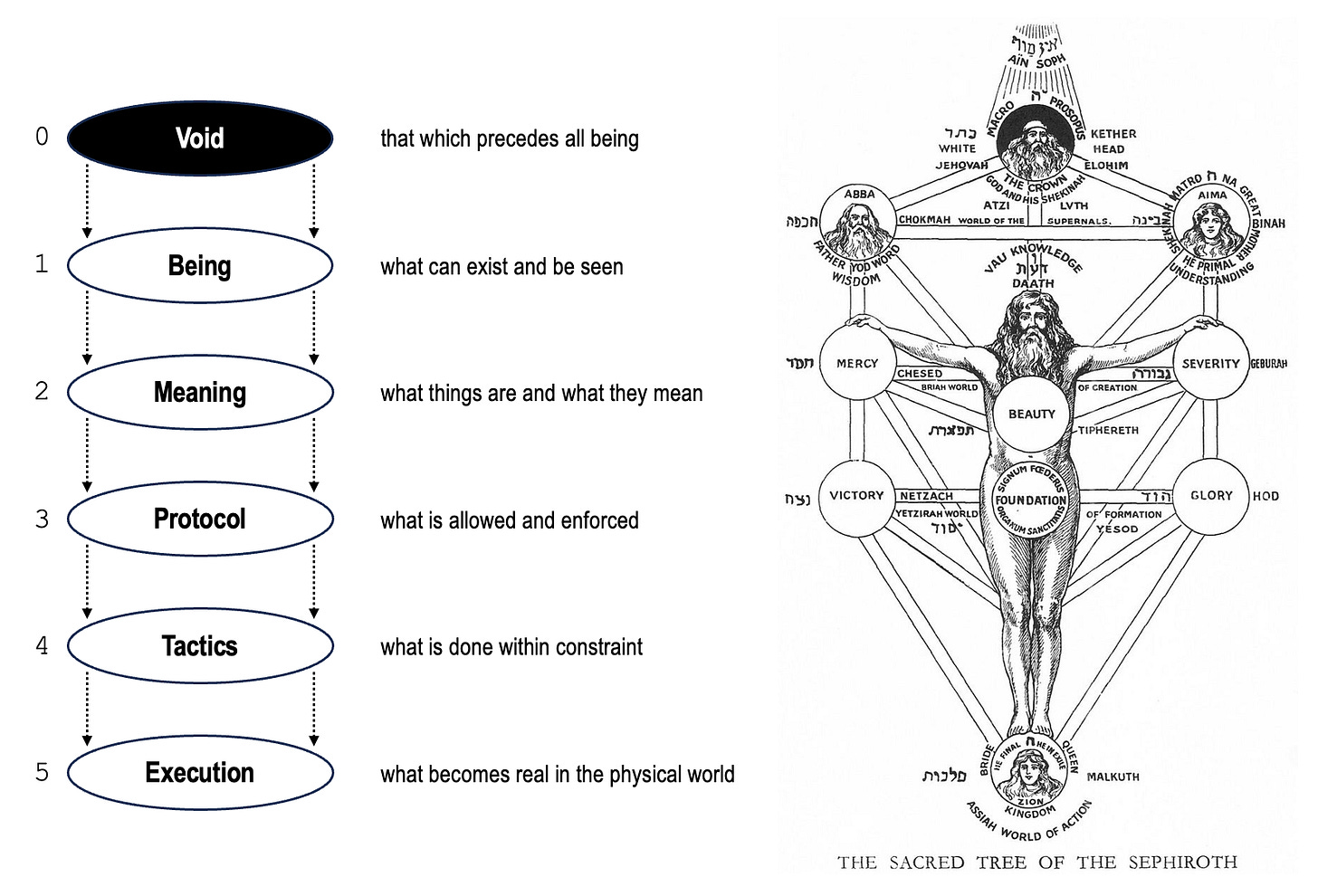A Cosmology of Power
This is what they don't want you to know
The Tao begot one. One begot two. Two begot three. And three begot the ten thousand things.
– Tao Te Ching, trans. Gia-Fu Feng and Jane English
A number of esoteric traditions understand the structure of the universe to be a composed of a series of emanations that flow outward from the Void—the Godhead, that which precedes all Being. As each radiates further from source, it takes on structure and constraint, coagulating, finally, into the density of the material world.
These emanated realms can be imagined as layers of abstraction that together make up the architecture of reality. The reality we perceive with our senses is only the final layer, which contains within it the embedded logic of the more abstract strata that precede it, and from which it arises.
Everything that enters human reality begins upstream. First as a flicker of inspiration, then grasped as an idea. The idea gains structure as it’s formalized into a plan. Then action is taken, finally bringing it into physical form.
But to speak of how anything enters the world we must also speak about power. Power is the capacity to cause or prevent change within a system. This is intuitive: if you can change something, you have power over it; if something can change you, it has power over you.
Each movement down the chain of abstraction requires a force to drive the transition. Something must determine it is this, and not anything else, that comes into Being. Power is the means by which reality gets made, by which all things in our world come to pass.
Power can be enacted at any level of abstraction, though it’s higher-leverage—and less visible—the further up it can exert its influence.
What follows is an emanationist model of power, in which I divide reality into Five Layers and trace how these Layers shape what is seen, what is valued, what is enacted, and what ultimately becomes real.
Layer 1: Reality Definition
Layer 1 governs the conditions for entry into a shared reality (not reality in the metaphysical sense, but what is visible and stable enough to be a site of downstream power).
Our understanding of reality is limited, among other things, by our senses (and their technological extensions), the architecture of our mammal minds, our language, the information we have access to, and the epistemic paradigms we internalize and take for granted.
In our consensus reality, for example, ghosts aren’t real because they fall outside the dominant regime of scientific rationalism. Similarly, bacteria weren’t real to us until we discovered them with the microscope.
Likewise, when a few actors have access to privileged information that they withhold from the public, they function as gatekeepers of reality, defining what is allowed to exist for everyone else.
This is the highest level of power, nearly invisible: to shape what gets to become real.
Most powerful entities operate across a few different layers, but very few reach into Layer 1, with the power to define reality at scale. Two of them are the CIA and Jesus.
Layer 2: Encoding Meaning
While Layer 1 determines what things exist at all, Layer 2 decides what those things mean—how they’re categorized, interpreted, valued, and related to each other.
Power here lies not in direct action, but in structuring the sensemaking framework through which actions are evaluated.
The Meaning layer includes belief systems like religions and political ideologies, economic values (profit vs. sustainability), cultural hierarchies (refined vs. trashy), secular mythologies like progress and optimization, concepts like gender or race, and narrative regimes like the War on Terror or Wokeness vs. Anti-Wokeness.
It is a value system that determines whether individual freedom is prioritized over collective well-being. It is a narrative that either elevates an event into a national tragedy, or erases it entirely.
A protester is reframed as a terrorist. A substance is called not a medicine, but a drug. The key is that what something is taken to be determines what it can do and what can be done to it.
In Layer 2, memetic competition has intensified since the advent of the internet. Meaning has escaped from under the watchful gaze of its institutional babysitters, exploding into a balkanized landscape of warring tribes.
Entities that operate at Layer 2 change how the world is interpreted. Karl Marx, Carl Jung, Fox News, and Donald Trump have influence here.
Layer 3: Protocol Design
The Protocol layer links abstract concepts to outcomes by embedding ideas into rule-based systems that determine how people respond. The Layer 2 concept of “a crime,” for instance, triggers a certain set of responses on Layer 3: arrest, trial, punishment.
Layer 3 defines the rules of a system: what can be done, by whom, when, under what conditions, and with what consequences. It governs what’s allowed and forbidden, what’s encouraged and discouraged. Internalization of the Protocol layer sounds like: “this is just the way things have always been done.”
Protocols include formal systems—laws, TCP/IP, crypto consensus mechanisms, voting, the wage labor system—as well as informal norms—working a 9-to-5, social hierarchies, table manners, taboos.
Layer 3 also includes incentive design, which shapes behavior not by forbidding actions outright, but by gently tipping the scales. Capital, for instance, is a protocol that assigns greater financial reward to specific actions, making them feel smart or necessary, while making others feel risky or illogical. Over time, people internalize these patterns, and start acting as if they’re choosing freely, even though the structure of the protocol has already narrowed the field.
Like all infrastructure, the Protocol layer is often invisible or written off as neutral, but its design comes with internalized assumptions and values, shaped by Layers 1 and 2 above it—sometimes consciously, sometimes not.
Like at the Meaning level, those operating at the Protocol level exert power not by acting directly, but by structuring the set of actions it’s possible and impossible, convenient and inconvenient, for others to take. Because of this, it is difficult for the average person to choose moves outside the scope of protocols.
One can, of course, attempt to change the protocol or write a new one. Some blockchain projects, like Bitcoin, Ethereum, and Quadratic Voting, aim to intervene directly at this layer, writing new protocols for finance and governance.
The primary agents operating at Layer 3 at scale are governments, which define legal personhood, ownership, mobility, and even the conditions of life and death.
Tech platforms also operate at the protocol level, with Apple governing through its App Store rules, Google via its search ranking logic, and Meta and TikTok through their social feed algorithms.
Elon Musk’s purchase of X, and subsequent change of the algorithm, was a Layer 3 move.
Layer 4: Tactical Operation
Layer 4 is the highest layer at which most people will ever operate.
The Tactical layer isn’t about redesigning the system, but about navigating within its existing structure. Power here is shaped by position, timing, visibility, and available optionality. It’s about choosing when to act, how to act, shaping perception, coordinating others, and taking advantage of structural asymmetries.
Tactics at Layer 4 include: accumulating resources; deploying capital to buy speed, scale, attention, or access; embedding oneself into high-leverage networks; exploiting the logic of Layer 3 protocols, like gaming social media algorithms; waiting until the perfect moment to launch a product; and pre-empting interpretation of your actions by controlling your own narrative.
Layer 4 is where most agency is experienced, in the form of making decisions. But “you can just do things”—the classic Layer 4 call to arms—is only half-true; you have maximum discretion over how, when, and where to act, but zero control over the constraints and affordances you must act within, your reality having already been narrowly shaped for you in Layers 1-3.
Plenty of people achieve mastery at Layer 4. These include people who are famous for being good at what they do, like Ray Dalio, Ariana Grande, and Jeff Koons. Most entrepreneurs and companies also operate in Layer 4.
If one attains a high enough position within Layer 4, one can also begin to influence Layer 3. These people become their own centers of gravity as protocols begin to route around them. In other words, they become “above the law,” since the same rules that govern everyone else no longer apply to them. Some may even gain enough leverage to explicitly redesign protocols in their favor.
Layer 5: Material Execution
Layer 5 governs execution. After all decisions have been made, the last step is the exertion of physical energy to achieve a result. Usually, those operating at Layer 4 will delegate this step out to others.
At the Execution layer, decisions are converted into outcomes, and optionality is destroyed in the process. Actions cannot be reversed, the system cannot revert to a prior state, the world hardens into form.
But every act, once made real, reshapes the world to create new initial conditions that feed back into the system. Changes in material conditions can shift how people behave, induce institutional adaptation, alter what is celebrated or condemned, and even change what is recognized as real. Materiality folds back into potential. The world is always re-making itself.
Most people will only ever operate in Layer 5, executing tasks shaped by upstream systems, with very limited Layer 4 maneuverability. Their actions reflect internalized values and protocols which define what actions feel available to them. Depending on which they’ve absorbed, they could lead the life of a Product Manager in California or an Amish carpenter in Pennsylvania. Competition between worldviews, value systems, incentive structures, and information at higher layers produces, in effect, a patchwork of available realities at Layer 5, some of which are more subscribed to than others. What feels like autonomy is often just choosing one, or a combination, of these pre-structured paths.
Sometimes people at Layer 5 will still exert Layer 4—or even Layer 3—power in highly localized social settings. For example, if they become the center of a social group, they may have protocol-level power, determining who to invite to their dinner parties or movie nights, and who gets to be accepted as part of the inner circle of friends.
Power at Layer 5 is minimal if it isn’t aggregated, organized, and directed at upstream layers. In esoteric traditions, the material world is the most dense, the least movable. It’s hardest to enact change from within this level. That’s why power usually operates from higher layers of abstraction, structuring the incentives that direct downstream action rather than executing the action itself.
It’s higher leverage to pay one hundred people to dig a hole (Layer 4) than it is to do it yourself (Layer 5). It’s even higher leverage to design the system of capital that enables the exchange of money for hole-digging (Layer 3), so that millions of people can dig millions of holes, any time, any place.
Labor unions have been one of the few mechanisms through which Layer 5 actors could exert upstream influence, historically even winning protocol-level gains like minimum wage laws, safety standards, and collective bargaining rights. When their power declines, so does the labor force’s ability to reshape protocol in its own interest.
To understand power is to see that the world is not simply happening; it is being made. This does not mean that everything around us has been deliberately engineered by a cabal of Illuminati. Beliefs, worldviews, and procedures tend to arise organically from an accumulation of cultural, social, and material conditions, as well as selection pressure and competition among meaning-making systems vying for mindshare. But once one can perceive the layered structure of reality—which determines what is seen, what is valued, and how things are done—one can begin to locate where influence might be possible.
We want to believe that we are in command of our own lives, but some decisions will always have been already-made for us, some paths already laid. We do not begin with freedom, but with inheritance. Most lives are dramas played out at the end of a long chain of upstream decisions. We can never not be-in-the-world. We are already in it.
Remember: what is not named may as well not exist. And if something does not exist, it can act as it pleases. Once the architecture of power is made visible it can be questioned and resisted.
The question is, then, which parts do we accept, which do we ignore, which do we opt out of, and which do we try to change?
After Tao was lost, then came the “power”; After the “power” was lost, then came human kindness.
After human kindness was lost, then came morality; After morality was lost, then came ritual.
– Tao Te Ching, trans. Arthur Waley





"Two of them are the CIA and Jesus."
What a line!
This maps nicely to Causal Layered Analysis (Inayatullah):
Void/Being = Myth
Meaning = Worldview
Protocol/Tactic = Causes
Execution = Litany
Great entry. A deep code power literacy is indeed needed.
“Understanding power empowers.” - Peter Sjöstedt-H
+
“Behold, I send you forth as sheep in the midst of wolves. Be ye therefore wise as serpents and harmless as doves." - Matthew 10:16
Really needed someone to explain this whole ladder in this way